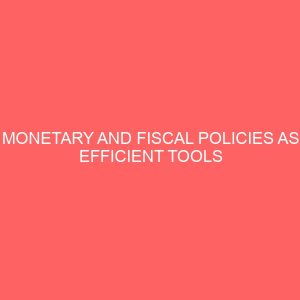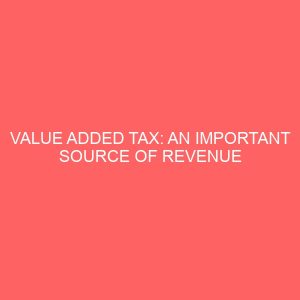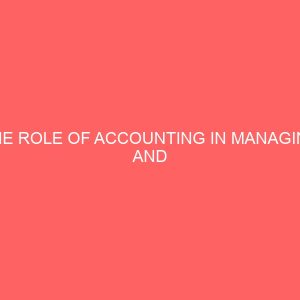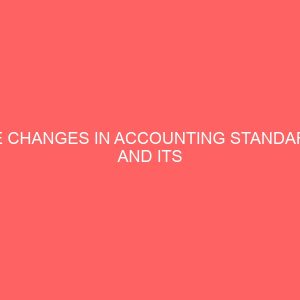Description
THIS RESEARCH WORK IS ON MONETARY AND FISCAL POLICIES AS EFFICIENT TOOLS FOR ECONOMIC STABILITY WITH SPECIFIC TO CENTRAL BANK OF NIGERIA
ABSTRACT
This research wok, treated monetary and fiscal policies as efficient tolls for economic stability. This research work was done to examine the monetary and fiscal policies and ascertain how effective they have been in making the poor conditions of the rural area fair, to ascertain why there should be poor unemployment in the economy despite the existence and fiscal policies and to identify the country’s economic problems with a view to offer lasting solution ot them. The method for sourcing data used in this research work, was primary and secondary data. Primary data includes: questionnaires comprising statement drawn from research, questionnaires formulated and oral interview while secondary data includes the use of textbooks, journals, internet. Findings and annual reports. The analysis of data was done using numerical and percentage techniques a d tables were also used to test the response. The method used in testing the research questions is the use of statistical method like percentage from the analysis, it revealed that there are major policies which the government and monetary authorities must endeavour to maintain and apply appropriately. Useful recommendations are made based on the findings from the study, that government and monetary authorities should endeavour to mountain and apply these efficient tools. And when policy measures are well implemented, there will be great improvement in the economy of the country.
TABLE OF CONTENTS
Title page
Approval page
Dedication
Acknowledgement
Abstract
Table of contents
CHAPTER ONE:
1.0 Introduction
- Background of the study
- Statement of problem
- Purpose / objective of the study
- Research Questions
- Significance of the study
- Scope of the study
- Limitations of the study
- Definition of operational terms
CHAPTER TWO:
2.0 Review of Related Literature
- Preamble / Introduction
- Definition of monetary policy
- Monetary and fiscal policies differentiated
- Objectives of monetary policy
- Objectives of fiscal policy
- Tools / instrument of monetary policy
- Theoretical framework tool / instrument of fiscal policy
- Monetary and Fiscal policies in the Nigeria Economy
- Monetary and Fiscal policies as efficient tools of Economic Development
CHAPTER THREE:
3.0 Research Methodology
3.1 Research Design
3.2 Area of the study
3.3 Population of the study
3.4 Sample and sampling techniques
3.5 Instrument for data collection
3.6 Description of instruments used
3.7 Validation and Reliability of Instrument
3.8 Distribution and Retrieval of the instrument
3.9 Method of data Analysis
CHAPTER FOUR:
- Data presentation and Analysis
CHAPTER FIVE:
5.0 SUMMARY, CONCLUSIOIN AND RECOMMENDATION
- Summary of the Findings
- Conclusion
- Recommendation
References
Appendix A
Appendix B
Questionnaires
CHAPTER ONE
1.0 INTRODUCTION
1.1 BACKGROUND OF THE STUDY:
The need for the monetary and fiscal policies had always existed, though not really recognized in the banking system and in the economy at large. The increase rate of money circulation in the economy, due to the rapied growth of commerce and industry has made the monetary authori3es (central Bank of Nigeria) increasingly Interested in making an effort to have money supply and credit conditions controlled, so as to maintain a relative economic stability. And so, the central bank of Nigeria was empowered to carryout the monetary formulation and execution in consultation with the federal ministry of finance.
Also, the need to generate revenue for the increase of investment and the pattern of expenditure for the purpose of influencing economic activities glares for the formulation of fiscsla policy. The economy has also witnessed a lot of economic depression, especially the great depression of 1930. as they continued having an unbalanced budget or the budget adding to the cyclical flunctuations, there was the need for these economic ills to be corrected and the fissal policy succeeded in correcting these ills of the economy. The fact was further influenced by the emergence of growth and stability concept. In othr words, if any economy remains in equilibrium with resources only partially employed, something must be done to unemployment.
Therefore, to increase this level, employment could be done in two ways: it could be either directly tackling the problem by employing more workers or directly tackling it by offering inducement to produce or to increase instrument. Indeed, the monetary and fiscal policies direct the total repentance on the economy. Their effectiveness as stabilization or efficient tools remains an unsettled issue among economists. They have been the efficient tools of economic stability.
According to John Orji in his book titled “Element of banking” he listed measures to be applied in using fiscal policy to solve economic problems or make the economy stable as thus:
- Fiscal policy and Recession: When aggregate demand for goods and services, the level of employment and prices are generally low, the economy is said to be faced with recession. In order to get the economy out of recession, the government can apply fiscal policy to solve the problem by taking the following objectives. Reduction in taxation, increase in government expenditure, grants to industries and banks.
2 Fiscal Policy and Inflation: Inflationary pressure is experienced when the aggregate demand is higher them aggregate supply the price level tend to rise, thereby making the banks to borrow. The resulting inflation can be controlled by fiscal policy by employing the following methods: increase in taxation, reduction in government expenditure, reduction of financial grants to firms etc.
1.2 STATEMENT O PROBLEMS
There has been instability in the economic system consing**** from flow of money. There has never been sufficient time required for their policy weapon on such key economic variable’s which is of crucial importance as an instrument of economic stabilization. There has been situations where there is either excess or shortage which has often affected unwarranted unbalances or destabilization in the economy. Such instability or unbalance has never encouraged economic growth. In other words, monetary and fiscal policies in most cases, have been retarded which result in unbalance in the economy.
1.3 PURPOSE OF THE STUDY
In view of the background, the policies aimed at maintaining economic stability, therefore this work aims specially to achieve the following objectives:
- To examine the monetary and fiscal policies and ascertain how effective they have been in making poor conditions of the rural areas fairs.
- To know why despite the monetary and fiscal policies formulated for economic development, the rural areas are still under-developed and under-utilized for much needed economic transformation of the country.
- To ascertain whether rural dwellers are included in the various policies mapped out yearly, by the government vice central banks, commercial banks and other financial institutions.
- To determine why there should still be unemployment in the economy, despite the existence of monetary and fiscal policies
- To ascertain why monetary and fiscal policies as an instrument of economic stabilization.
- To indemnity the country economic problem with a view to offer lasting solutions to them.
1.4 RESEARCH QUESTION
The research questions include:
- Is monetary and fiscal policies really the efficient tools to economic stability?
- Do monetary and fiscal policies contribute in growth of the country economy
- Has there been unbalance in he economy due ot monetary and fiscal policies being retarded.
- Does the absence of monetary and fiscal policies do any harm to the economy?
- Do monetary and fiscal policies contributes positively towards improving an developing of rural areas.?
RESEARCH HYPOTHESIS
1. Ho: There has been instability in the economic system arising from.
flow of money and credit condition before the introduction and fiscal policies.
- HA: There has not been instability in the economic system arising form flow of money and credit condition before the introduction and fiscal policies.
3. Ho: There has been unbalance in the economy resulting from m monetary and fiscal policies being retarded
4. HA: There has not been unbalance in the economy resulting from m monetary and fiscal policies being retarded
1.5 SIGNIFICANCE OF THE STUDY
The There has been unbalance in the economy resulting from m monetary and fiscal policies being retarded
Cannot be over emphasized in the management of the economy. This study is of great importance to the society. So it will be deliberating on the need for a stable economy. Therefore, this study will help;
1. The government for a better budget planning so that there won’t be any suck case like shortage or excess in the economy after making the budget.
- The financial researchers for better judgement or better decision making and implementation.
- To bring up the need to apply the tools and to apply it correctly in the control of the economic decision making supply and economic depreciation.
4. To guide the central bank of Nigeria and the government on how to control the economy so as to avoid such cases as decrease of money in circulation (deflation) instead it will keep a stable economy.
5. To maintain stability in the external value of the currency using monetary policy.
6. To attain a high, rapid and sustainable economic growth
7. To maintain balance of payment equilibrium in the economy
1.6 SCOPE OF THE STUDY
This research work is limited only to Nigerian economy. The limitation in the Nigerian economy is with reference to central bank of Nigeria Awka.
Also the researcher went on extra mile to obtain information and statistics reasonable enough and for fiscal policies as efficient tool for economic growth and stability.
1.7 LIMITATION OF THE STUDY
In carrying out this project work, the research is faced with certain limitations among which are:
- TIME LIMIT: This is as a result of the short semester and tight academic schedule for lecture free period and weekends.
- FINANCE LIMIT: Because of the economic situation of the country and many expenses which has been met, the researcher is faced with limited finance, also the high cost of transportation, which is the reason why one cannot reach all the possible sources of information required for the project but nevertheless, enough information or data were collected.
1.8 DEFINITION OF OPERATIONAL TERMS
MONETARY POLICY: There are many definition of monetary policy as there are many writers on the topic. However, for the purpose of this study, a few definition will surface, for consideration. According to Nwakpa P.N, monetary policy are the various ways which the federal government and the central bank seek to influence the supply of credit as well as their price in order to achieve a stated described economic goal. The desired goal include, to improve the rural area and maintain healthy economy. According to John Orjih in his book titled “Elements of banking” Defined Monetary Policy as, any conscious action undertaken by the monetary authorities to change the volume, quantity, availability, cost and direction of money and credit in a given economy. He also went further to define it as the credit control measures adopted by central banks ot control the supply of money as an instrument for achieving the objectives of general economic policy. According to Okpala C.M. In his book titled “Banking in Nigefia issues and concept” defined monetary policy as: A deliberate effort by the monetary authorities (The central bank) to control the money supply and credit contributions for the purpose of cachieving certain broad economic objectives usig the following instrument tools.
- Open Market Operation (OMO): This is an activity of buying and selling of government securities in the open market by the central bank of Nigeria. When prices rise, and there is the need to control them, the CBN sells securities to the public. These securities includes: treasury bills, government bonds, treasury certificates etc.
2. Legal reserve Ratio: This is the ratio of cash reserves that banks are required to maintain. It is the percentage of commercial bank deposits (from customers) that the central bank requires them to set aside either in an account with the central bank (cash ratio) or in approved securities that is liquid assets.
3. Discount Rate / Rediscount rate (Bank rate: This is the rate at which the central bank lend money to commercial banks, discount house, and other financial institutions (rediscount rate).
4. Liquidity Ratio: This is a method which compels the banks to spread / diversify their portfolio of liquid assets holding
5. Moral suasion: This is a credit control measure applied by the central bank of Nigeria which involves informal discussions with the official of commercial banks.
6. Directives: This is a method applied by the central bank in giving instructions about the credit and banking policies that could be pursued by the financial sector for a given fiscal period.
7. Fiscal Policy: This is he means by which a government adjusts it’s spending levels and tax rates to monitor and influence a nations economy. According to the oxford Advanced Dictionary, it defined fiscal policy as the creation of tax structure and the determination of the amount of tax revenue and the direction of government expenditure for the purpose of attaining a specific objective such as: greater dependence on our own resources through development of the area.
According to Okpala C.M in his book titled “Budgeting” the defined fiscal policy as government’s conscious attempt to client the economic activities towards achieving growth and stability.
According to C.C.N Asuzu (1995), he defined fiscal policy as that part of government policy concerning the raising of revenue through taxation and other means and deciding on the level and pattern of expenditure for the purpose of influencing economic activities.
These economic activities are directed towards the broad objectives of attaining economic growth and stability.
8. Economic Growth: Simply means a rise in the per-capital income of a given economy.
9. Economic stability: Means a situation characterized by stability in he price level and full employment
10. The Budget: Fiscal policy is implemented through changes in the budget. The budget is a financial statement of the sources (revenue) and uses (expenditure) of fund of the government, which is prepared by the ministry of finance for discussion and approval.








Reviews
There are no reviews yet.